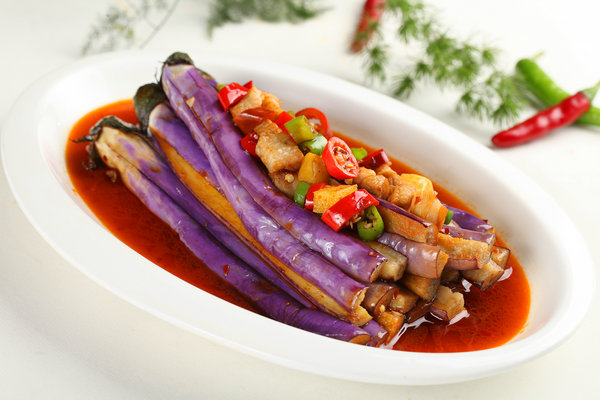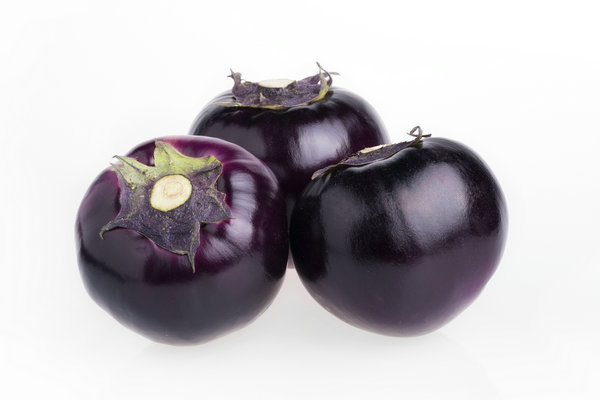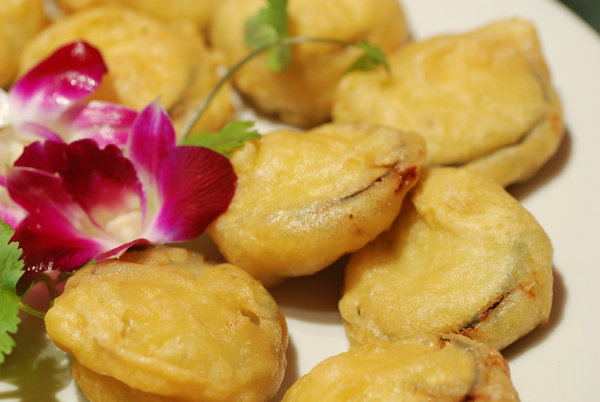


Steamed eggplant with stir-fried minced pork and fried eggplant sandwiches are among a variety of Chinese eggplant recipes. [Photo provided to China Daily]
They are mainly purple, but also come in white and green. They can be as small as a thumbnail or as big as a small football, and can be long and thin, egg-shaped or round.
This is the eggplant, also known as aubergine in certain European countries, and brinjal in Southeast Asia.
It is an enigmatic fruit, classified as a berry but mostly eaten as a vegetable. It should always be cooked well to neutralize the bitter seeds.
Some people hate it and others love it so much that the finished dish is reserved only for favored sons.
In Japan, for instance, there is an old folk saying: "Don't waste nasu on a daughter-in-law." Of course, we hasten to add that it's an obsolete attitude and nasu, or eggplant, is a universal favorite in Japan.
Cooking it requires confident kitchen skills. The spongy, dry texture of the eggplant needs sufficient heat to tenderize and enough oil to turn it into a creamy sweet pulp.
Even when it is made into a pickle, it has to be steamed first, unlike other vegetables.
Perhaps because of its need for such attention, the eggplant is not a favorite on Western menus. Its popularity started in the Middle East and lower Mediterranean, then spread eastward all the way to India, sweeping down to Southeast Asia, then on to China.
In these countries, there are many dishes that prominently feature the eggplant.
There is moussaka-layers of eggplant and minced meat baked under a cheese sauce-or baba ghannouj, a savory eggplant mash eaten as a dip, both from the Middle East. In India, eggplant is made into relishes and curries, while in Thailand tiny button eggplants go into curries and spicy sour soups the region is famous for.
Eggplant has been eaten in China for thousands of years, and it is roasted, fried, steamed, braised and pickled in a huge variety of recipes.
The plant is treated as an annual in the temperate parts of China, but in the south its habits are perennial. It grows almost as tall as a man, blossoming in late spring to early summer with tiny purple or white flowers that develop into fruit.
The berries are sheltered by large palm-shaped leaves before they grow big enough to catch the sun. Eggplants are best eaten young, since the mature seeds get very bitter because they contain nicotinoid alkaloids.
The eggplant is considered a "cooling" food in traditional Chinese medicine and is recommended for summer. It is rich in calcium, potassium and vitamins, especially vitamin E. Traditional Chinese medicine says it is good for blood circulation and the digestive system.

[Photo provided to China Daily]
Steamed eggplant with coriander
4-6 long purple eggplants
2-3 sprigs coriander
2-3 cloves garlic
1-2 red chili peppers
2 tablespoons oil
1 tablespoon soy sauce
1 tablespoon sesame oil
1 tablespoon toasted sesame seeds Steam the eggplants whole over very high heat for 30 minutes.
Wash the coriander, then pick off the whole leaves and roughly chop. Next, skin the garlic and mince. Seed the red chili peppers and finely dice.
Remove the steamed eggplants and, using a fork, run its tines down the length, shredding them.
Plate the eggplants and spoon the garlic, chili and coriander on top.
Heat up the oil, soy and sesame oil in a small pot and pour the sizzling mixture over the eggplant. Top with toasted sesame seeds. Serve at once.
Fried eggplant sandwiches
300 g minced belly pork
50 g salty Chinese ham, finely diced
2-3 water chestnuts, peeled and minced
1 tablespoon cornstarch
Salt and pepper
1 egg, beaten
2-3 eggplants
Batter ingredients:
1/2 cup flour
2 tablespoons cornstarch
Salt and pepper
1 egg yolk
A little iced water

Steamed eggplant with stir-fried minced pork and fried eggplant sandwiches are among a variety of Chinese eggplant recipes. [Photo provided to China Daily]
Mix together pork mince, diced ham and water chestnuts. Add the egg and cornstarch, salt and pepper. Stir vigorously in one direction until the meat mixture turns starchy.
Prepare the eggplants by slicing each diagonally into 2-cm-thick pieces. Make a slit in each slice to create a pocket without cutting right through.
Dust each eggplant pocket with some cornstarch and fill with a spoonful of meat mixture. Squeeze the sides together slightly to lock and distribute the mixture.
Make the batter. Beat up the egg yolk and add the plain flour and cornstarch, mixing it well. Add a lit-tle water if necessary to get a batter with a smooth dropping consistency. Add salt and pepper.
Prepare two cups of oil in a frying pan, and heat until the surface shimmers.
Dip each eggplant sandwich in the batter and slide it in the hot oil. Fry until golden brown, then drain well on kitchen paper.
Serve with a sweet vinegar and garlic dip. Mince a clove of garlic and add to a bowl of black vinegar sweetened to taste with honey.
Eggplant, Sichuan-style
This is yuxiangqiezi, a very popular spicy eggplant dish using lots of the bean paste chili sauce doubanjiang.
3-4 eggplants, about 400 g
250 g minced pork
1 tablespoon minced ginger
1 tablespoon minced white of leeks
1 tablespoon minced garlic
2-3 red chili peppers, diced
Coriander for garnish
1 teaspoon sweet bean paste, tianmianjiang
1 heaping tablespoon hot bean paste, doubanjiang
1 teaspoon sugar
Cut the eggplants into 2-cm chunks. Deep-fry them in very hot oil until they just change color. Drain immediately and reserve.
Pour away most of the oil, leaving about a tablespoon in the pan, and fry the minced ginger, leek and garlic. Add the chili. When the mixture is fragrant, add the minced pork and the sweet and hot bean pastes.
Finally, add the eggplants and toss to coat with the spicy mix. Cover the pan and cook for five minutes. Remove the pan cover and add a splash of water and the sugar.
Adjust the seasoning after tasting, then toss for a minute more and plate.
Beijing pickled eggplant
6-8 tender short fat eggplants
Salt
Garlic (about a whole bulb)
Steam the eggplants over high heat until they are soft. Cool completely.
Peel as much garlic as you want and mince it with a teaspoon of salt.
Tear the cooled eggplant into quarters and sprinkle some salt over the insides. Smear with a thick layer of minced garlic.
Pack everything into an airtight container, such as Tupperware with a lid, and set aside at room temperature for a day. Open the lid the next day and you should smell a slightly sour aroma.
Keep the pickled eggplants in the fridge, and enjoy them as a summer side dish.

 Award-winning photos show poverty reduction achievements in NE China's Jilin province
Award-winning photos show poverty reduction achievements in NE China's Jilin province People dance to greet advent of New Year in Ameiqituo Town, Guizhou
People dance to greet advent of New Year in Ameiqituo Town, Guizhou Fire brigade in Shanghai holds group wedding
Fire brigade in Shanghai holds group wedding Tourists enjoy ice sculptures in Datan Town, north China
Tourists enjoy ice sculptures in Datan Town, north China Sunset scenery of Dayan Pagoda in Xi'an
Sunset scenery of Dayan Pagoda in Xi'an Tourists have fun at scenic spot in Nanlong Town, NW China
Tourists have fun at scenic spot in Nanlong Town, NW China Harbin attracts tourists by making best use of ice in winter
Harbin attracts tourists by making best use of ice in winter In pics: FIS Alpine Ski Women's World Cup Slalom
In pics: FIS Alpine Ski Women's World Cup Slalom Black-necked cranes rest at reservoir in Lhunzhub County, Lhasa
Black-necked cranes rest at reservoir in Lhunzhub County, Lhasa China's FAST telescope will be available to foreign scientists in April
China's FAST telescope will be available to foreign scientists in April